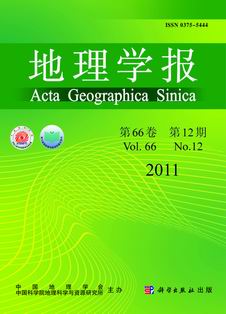WANG Zhenbo, FANG Chuanglin, WANG Jing
Based on the Landsat TM remote sensed imageries in the periods of 1991, 2001 and 2008 Yangtze Delta Economic Region, and taking 90 counties in this region as basic units, this paper builds spatial data transformation models, i.e., the ESV and the EEH models. Spatial analysis of massive vector and raster data were done within the environment of ArcGIS 9.3. The ESV index and the EEH index reveal the relationship between economic development and eco-environment system of the Yangtze River Delta and its evolution . Furthermore, the function regionalization and the model modification were developed. The results are shown as follows. (1) Since 1991, the conversion of land-use type has been significant, and the city and town land has converted mainly from the paddy field, dry land, grass land, garden plot and other lands. (2) The ESV model shows that the eco-system tends to be degraded in the 9101 period of time, while in the 0801 period, the degradation trends are less significant. At the same time, it proves that the development pattern of the conversion of water body and paddy field to the city, town and dry land deteriorated the eco-system severely. (3) Since 1991, GDP in the central and southern parts is lower than that in the northern, and GDP growth rate in the central part for the 9101 period is higher than that in the northern, while in the 0108 period, it is higher than those in the central and southern parts. (4) According to EEH index, the paper divides Yangtze Delta Economic Region into 12 zones. The spatial characteristics of the EEH are: ecological conflict zone and ecological coordination zone are located in the center and fringe areas respectively, presenting a "core-fringe" structure in the "low to high" order, and in 9101 period eco-economic relationship tends to be concentrated on initial degradation, while in 0108, it converses to dispersed degradation and coordination. (5) Using the model of spatial data transformation, five types of eco-economic evolution are identified, namely, initial degradation zone, initial coordination zone, continuous degradation zone, reduced coordination zone and increased coordination zone. (6) Finally, the paper summarizes the spatial evolution patterns of the Yangtze Delta Region: the coexistence of the gradient mode and the core-fringe mode. The former consists of three horizontal belts in the northern, central and southern parts as the first grade gradient mode and of three N-S belts along the east, middle and west for the second grade gradient mode. The latter consists of seven groups, which are Suzhou-Wuxi-Changzhou group, Nanjing group, Shaoxing-Ningbo group, northern Jiangsu group, Taizhou group, Hangzhou group and Nantong group. Different modes correspond to different evolution patterns of the eco-economic system, which reflects a spatial differentiation trend of eco-economic relationship at a high level.
